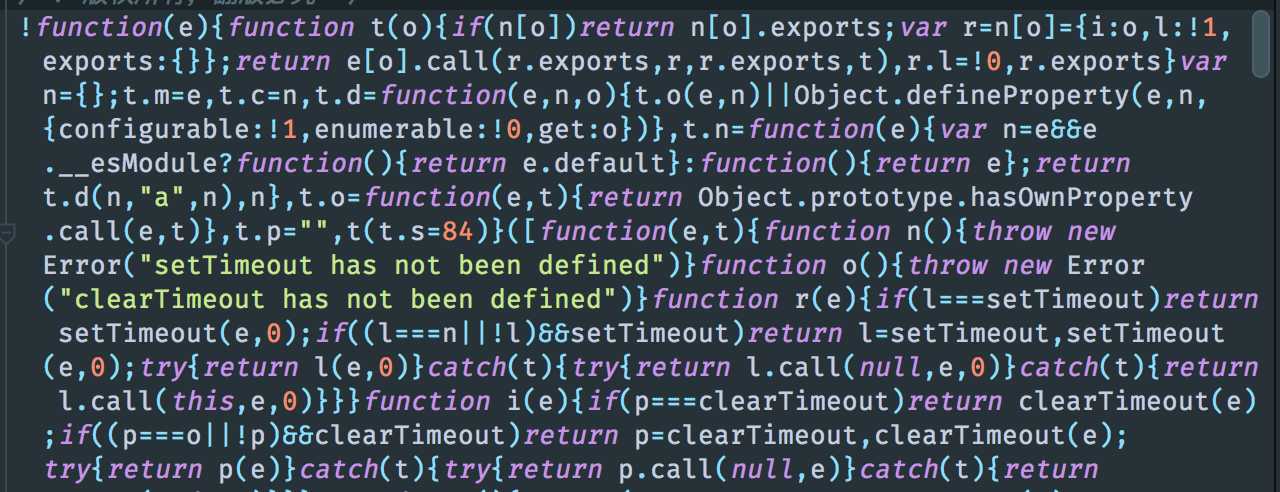标签:服务器 dep base tor 环境 功能 set 多次 ash
目前为止,我们已经使用webpack构建了一个完整的开发环境。但是在产品阶段,可能还需要对打包的文件进行额外的处理,比如说优化,压缩,缓存以及分离CSS和JS。
对于复杂的项目来说,需要复杂的配置,这时候分解配置文件为多个小的文件可以使得事情井井有条,以上面的例子来说,我们创建一个webpack.production.config.js的文件,在里面加上基本的配置,它和原始的webpack.config.js很像,如下
// webpack.production.config.js
const webpack = require(‘webpack‘);
const HtmlWebpackPlugin = require(‘html-webpack-plugin‘);
module.exports = {
entry: __dirname + "/app/main.js", //已多次提及的唯一入口文件
output: {
path: __dirname + "/build",
filename: "bundle.js"
},
devtool: ‘eval-source-map‘,
devServer: {
contentBase: "./public", //本地服务器所加载的页面所在的目录
historyApiFallback: true, //不跳转
inline: true,
hot: true
},
module: {
rules: [{
test: /(\.jsx|\.js)$/,
use: {
loader: "babel-loader"
},
exclude: /node_modules/
}, {
test: /\.css$/,
use: ExtractTextPlugin.extract({
fallback: "style-loader",
use: [{
loader: "css-loader",
options: {
modules: true
}
}, {
loader: "postcss-loader"
}],
})
}]
},
plugins: [
new webpack.BannerPlugin(‘版权所有,翻版必究‘),
new HtmlWebpackPlugin({
template: __dirname + "/app/index.tmpl.html" //new 一个这个插件的实例,并传入相关的参数
}),
new webpack.HotModuleReplacementPlugin() //热加载插件
],
};
//package.json
{
"name": "test",
"version": "1.0.0",
"description": "",
"main": "index.js",
"scripts": {
"test": "echo \"Error: no test specified\" && exit 1",
"start": "webpack",
"server": "webpack-dev-server --open",
"build": "NODE_ENV=production webpack --config ./webpack.production.config.js --progress"
},
"author": "",
"license": "ISC",
"devDependencies": {
...
},
"dependencies": {
"react": "^15.6.1",
"react-dom": "^15.6.1"
}
}
注意:window下的build后应该这样写:"set NODE_ENV=production webpack --config ./webpack.production.config.js --progress"
webpack提供了一些在发布阶段非常有用的优化插件,它们大多来自于webpack社区,可以通过npm安装,通过以下插件可以完成产品发布阶段所需的功能
OccurenceOrderPlugin :为组件分配ID,通过这个插件webpack可以分析和优先考虑使用最多的模块,并为它们分配最小的IDUglifyJsPlugin:压缩JS代码;ExtractTextPlugin:分离CSS和JS文件我们继续用例子来看看如何添加它们,OccurenceOrder 和 UglifyJS plugins 都是内置插件,你需要做的只是安装其它非内置插件
npm install --save-dev extract-text-webpack-plugin
在配置文件的plugins后引用它们
// webpack.production.config.js
const webpack = require(‘webpack‘);
const HtmlWebpackPlugin = require(‘html-webpack-plugin‘);
const ExtractTextPlugin = require(‘extract-text-webpack-plugin‘);
module.exports = {
entry: __dirname + "/app/main.js",//已多次提及的唯一入口文件
output: {
path: __dirname + "/build",
filename: "bundle.js"
},
devtool: ‘none‘,
devServer: {
contentBase: "./public",//本地服务器所加载的页面所在的目录
historyApiFallback: true,//不跳转
inline: true,
hot: true
},
module: {
rules: [
{
test: /(\.jsx|\.js)$/,
use: {
loader: "babel-loader"
},
exclude: /node_modules/
},
{
test: /\.css$/,
use: [
{
loader: "style-loader"
}, {
loader: "css-loader",
options: {
modules: true
}
}, {
loader: "postcss-loader"
}
]
}
]
},
plugins: [
new webpack.BannerPlugin(‘版权所有,翻版必究‘),
new HtmlWebpackPlugin({
template: __dirname + "/app/index.tmpl.html"
}),
new webpack.optimize.OccurrenceOrderPlugin(),
new webpack.optimize.UglifyJsPlugin(),
new ExtractTextPlugin("style.css")
],
};
此时执行npm run build可以看见代码是被压缩后的

缓存无处不在,使用缓存的最好方法是保证你的文件名和文件内容是匹配的(内容改变,名称相应改变)
webpack可以把一个哈希值添加到打包的文件名中,使用方法如下,添加特殊的字符串混合体([name], [id] and [hash])到输出文件名前
const webpack = require(‘webpack‘);
const HtmlWebpackPlugin = require(‘html-webpack-plugin‘);
const ExtractTextPlugin = require(‘extract-text-webpack-plugin‘);
module.exports = {
..
output: {
path: __dirname + "/build",
filename: "bundle-[hash].js"
},
...
};
现在用户会有合理的缓存了。

标签:服务器 dep base tor 环境 功能 set 多次 ash
原文地址:http://www.cnblogs.com/ldlx-mars/p/7748656.html